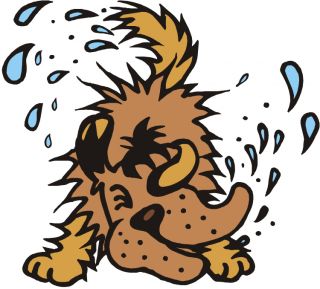Intelligence
Science Looks at Why and How Wet Dogs Shake
Shaking water from a dog’s fur is a survival skill
Posted September 10, 2012
So I have just finished bathing my Cavalier King Charles Spaniel, Ripley. Next I reach for a towel to dry him off, when he gives the classic wet dog shake. As a result I am now soaking wet, and my dog is nearly dry. My response to this is to snort, and to feel a bit stupid for not having the towel closer at hand. When David Hu, a professor of biology and engineering at Georgia Institute of Technology in Atlanta, observed a similar event involving his fiancée's miniature poodle Jerry, his response was to rush the dog into his laboratory and begin wetting it down and recording its responses with an ultra high-speed camera.

It turns out that we didn't really know how such shakes worked until Dr. Hu and his students Andrew Dickerson and Zachary Mills turned their water hoses and their cameras (plus some high-powered mathematics) on the problem. What they found was that a dog can shake nearly 70 percent of the water from its fur in about 4 seconds.
The first question to ask is why a dogs shaking is such an effective method of drying his fur. The mechanics are puzzling. A dog's backbone can't really twist around quickly enough or far enough to do the job. It can only move around 30° in either direction, so if you imagine a clock face with the backbone at 12 o'clock it is really just twisting between the 11 and 1 marks. However the drying process is greatly assisted by the fact that dogs have very loose skin. So as the dog shakes his skin is actually swinging 90° in either direction, which on our clock face would move between the 9 o'clock and 3 o'clock marks. Furthermore, the skin is whipping far faster than the backbone. This generates forces of between 10 and 70 times that of gravity — high enough that the animals have to close their eyes to prevent damage from the extreme centripetal forces.
The Georgia researchers found that this shaking trick is not unique to dogs after studying 16 soggy species, including mice, dogs, tigers and bears, at Zoo Atlanta. With so many furry species showing this same adaptation, one must ask why it evolved in the first place. Well let’s consider a simple scenario. You are the ancestor of our modern dog and you have just crossed over a cold stream and are soaking wet. It is critical that you dry off because water destroys the insulation properties of your fur and without something to preserve your body heat you might well die of hypothermia. If it happens that there isn't a warm sun to do some of the evaporating then you've got to find a means to dry yourself. Suppose that you didn’t have the ability to shake the water off. That means that you would have to use your body heat to warm the air and do the evaporation. That would expend a lot of energy. For example, Dr. Hu’s team estimates that a wet 60-pound dog, with one pound of water in its fur, would use 20 percent of its daily caloric intake simply to air-dry. It is a matter of life or death that a furry animals stays dry in cold weather since the way that fur insulates is by trapping warm air between the hairs and wetness nullifies this process. In contrast, the shaking mechanism is a highly energy-efficient way of getting mostly dry.
One fascinating additional finding from this research is that animals tune the frequency of their shaking oscillations. The basic requirement is to generate enough force to throw the water off of their bodies. Imagine two wheels, one with a large radius, and one much smaller. Now imagine that we have some water droplets on each of the wheels and we want to spin the wheels to get the water to fly off. Because of the physics of centripetal force we would have to spin the smaller wheel much faster to generate the energy necessary to shed the water. The same goes for animals. A larger dog (with a larger body radius) can get away with a slower shaking oscillations than a smaller one. Thus the researchers found that Labrador Retriever shakes at a rate of 4.5 Hz (Hz is a measure of cycles per second), while a Chihuahua shakes at 6.8 Hz. You can get a much more extreme variation in the rate of shaking if we look at very big versus very small animals. The research group found that a mouse must shake at 29 Hz, while a brown bear need only shake at a rate of 4 Hz dry off.
For we relatively hairless human beings, shaking does not provide much effective drying. So use the towel after your shower rather than trying to shake like an over stimulated break dancer.
You can see a fascinating video showing these shaking behaviors in dogs and other species by clicking here.
Stanley Coren is the author of many books including: Born to Bark, Do Dogs Dream? The Modern Dog, Why Do Dogs Have Wet Noses? The Pawprints of History, How Dogs Think, How To Speak Dog, Why We Love the Dogs We Do, What Do Dogs Know? The Intelligence of Dogs, Why Does My Dog Act That Way? Understanding Dogs for Dummies, Sleep Thieves, The Left-hander Syndrome
Copyright SC Psychological Enterprises Ltd. May not be reprinted or reposted without permission


